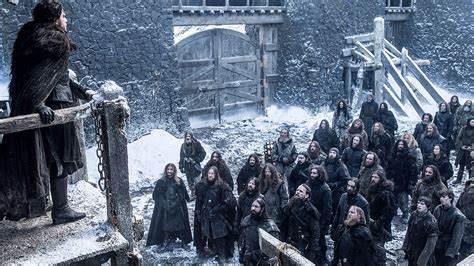Fantasy Worldbuilding Like George R.R. Martin

Worldbuilding is an intrinsic part of the fantasy genre and doing it well will level up your work. That said, it’s hard to define precisely what good worldbuilding is, much less how to do it. And harder still, to put it into your narrative cohesively.
Today, I want to break down the worldbuilding of George R.R. Martin to give you some real-world (no pun intended) examples of good worldbuilding techniques and why they work. So, without further ado, let’s get into fantasy worldbuilding like George R.R. Martin.
Martin does many things well in his books, but I want to focus on key things you can translate to your work. They are:
- Integrating your world into your narrative
- Setting an overall tone for your world
- Using character POV to your advantage
- The “name it and drop it” technique to help with pacing
- Rooting things in the human struggle
Hearing the terms isn’t enough. Below, I’ll explain each of these techniques in detail and show actual, in-book examples from Martin’s first Song of Ice & Fire book. So, not only will you learn them in practice, but you’ll also see exactly how and why they work. Sound good? Cool. Let’s get started.
Fantasy Worldbuilding: Lessons From George R.R. Martin
Fantasy is such a big genre, and writers have different styles and goals. So, while it’s hard to say Westeros is a perfect example of worldbuilding in all contexts, Martin does some things exceptionally well that writers from all walks of life should know.
Aside from some tips on building your world, we’ll talk about integrating your world into your writing so that it feels natural. For example, we’ll talk about pacing and other techniques to avoid info-dumping a lot of lore onto your readers at once.
Fantasy Worldbuilding Tips
Before we get to how best to introduce your world to your narrative, let’s review some tips to create your world and its lore.
1. Create a “Secondary Universe”
Martin emphasizes the need for a “secondary universe”—a familiar and distinct world. Drawing inspiration from medieval Europe, Martin crafted the Seven Kingdoms of Westeros, each reminiscent of different historical periods and regions. In short, it’s somewhat based on actual history!
For instance, the North echoes the rugged landscapes and feudal society of medieval Scotland, while the Reach evokes the chivalry and courtly intrigue of medieval France. Martin adds authenticity and depth to his storytelling by grounding Westeros in real-world history and geography.
You May Also Like: How To Write A Fantasy Novel – Tips & Tricks
Further still, you have the Dothraki – Martin has mentioned that the Dothraki were influenced by the Mongol hordes, particularly under Genghis Khan’s leadership, known for their fearsome cavalry tactics and nomadic lifestyle on the Eurasian steppes.
If you want to write highly detailed, realistic history like GRRM, what better place to look than the past? After all, the past is often stranger than fiction.
2. Be Highly Logical
Apply logic even in unexpected places to make your world feel authentic; Martin certainly did. Terry Pratchett once posed the question: “How does the shit get out, and the clean water get in?” and then built his own Discworld city meticulously around this practical concern.
Sewage systems aside, what he means by this is don’t neglect the minor things that make your world function. When your setting is the backdrop of massive, unbelievable things, it’s easy to forget the smaller details that contribute to the functionality of the world.
3. Write and Fill In
Martin doesn’t meticulously build the entire world upfront. Instead, he lets the writing breathe and fills in details as needed. He famously describes his writing process as “gardening” rather than “architecting,” allowing room for unexpected plot twists and character developments.
It would be best if you, too, allowed your world to evolve organically as you write, filling in details as needed rather than planning everything upfront. This approach keeps the story alive and allows for organic discoveries and a fluid narrative.
Check out some of Martin’s more helpful quotes in Famous Author Quotes To Improve & Inspire.
Seamless Worldbuilding And Narrative
Building your world is only half of the equation, and I dare say it’s often the easier half. With the tips above, you should be well on your way to creating a good setting for your fantasy novel. Now you have to start writing and introducing that world to readers in a way that doesn’t feel “info-dumpy” or in their face.
So, in this section, we’ll cover how to seamlessly write your world into your narrative. In this regard, George R.R. Martin is a master, and we can learn much from his work. He does this so consistently well that we need to look no further than the opening page of the first Song of Ice and Fire book – A Game of Thrones.
The book starts with these lines:
The morning had dawned clear and cold, with a crispness that hinted at the end of summer. They set forth at daybreak to see a man beheaded, twenty in all, and Bran rode among them, nervous with excitement.
This was the first time he had been deemed old enough to go with his lord father and his brothers to see the King’s justice done. It was the ninth year of summer, and the seventh of Bran’s life.
A Game of Thrones
Set The Tone
On first read, these opening lines may not seem particularly helpful in introducing the world and lore. After all, there’s no mention of essential families, castles, magic systems, etc. However, what these few lines do incredibly well is begin to set the tone for the world.
It tells you that Westeros (which would mean nothing to the reader at this point) is a land where seven-year-olds can watch beheadings and are excited about it.
We’re also introduced very casually to several details – The character’s age, the fact that there have been beheadings before, and that there have been nine years of summer. While these details may not be essential for the scene, they begin to lay the groundwork for the future right out of the gate and give readers a glimpse into what type of world Westeros is.
With these lines, Martin has effectively set the tone for the novel’s setting in two paragraphs.
Name-It And Drop-It
Continuing from above, the story reads:
The man had been taken outside a small holdfast in the hills. Robb thought he was a wildling, his sword sworn to Mance Rayder , the king-beyond the wall. It made Bran’s skin prickle to think of it.
He remembered the hearth tales old Nan told them. The wildlings were cruel men, she said, slavers and slayers and theives. They consorted with giants and ghouls, stole girl childern in the dead of night, and drank blood from polished horns.
And their women lay with the others in the long night to sire terrible half-human children. But the man they found bound hand and foot to the holdfast wall awaiting the king’s justice was old and scrawny, not much taller than Robb.
He had lost both ears and a finger to frostbite, and he dressed all in black, the same as a brother of the night’s watch, except that his furs were ragged and greasy.
A Game of Thrones
Here, you can see the “name-it and drop-it” approach that Martin often uses. He’ll take some character, lore, event, or history and unceremoniously mention it. Then, without going into detail about it, he moves on with the narrative, and sometimes, he won’t revisit the mentioned topic for pages, chapters, or even books.
You can see this above with mentions of Mance Rayder, the wildlings, the night’s watch, and the others. While all these things may be important to the overall series, they don’t pertain specifically to the current event. Mentioning them and not elaborating accomplishes a few great things.

First, it lets the reader know that the world extends far beyond the given page. Next, it builds interest and intrigue. It tells the readers there are many doors within the story while not telling them exactly what lies behind them.
So, remember that you can mention all your fantastic lore without having to go into detail about it just yet. Hopefully, you have a ton of cool things to say about the elements in your world, but it doesn’t all have to come at once, and it doesn’t have to happen fast.
Character Specific POV
The passage above also shows the power of a specific character’s point of view. For example, Bran is confident that the wildlings are savages, monsters, and thieves because that’s what he’s been told. However, in reality (spoiler alert), most are just regular people trying to survive like everyone else.
This biased point of view sets the foundation for different perspectives of the world, moral ambiguity, and cultural prejudice. All the while, considering it is but one character’s thoughts (and not stated as fact), the readers still have much to consider and interpret themselves.
Beyond that, a specific character’s POV contributes to the name-it and drop-it technique. In this case, Martin can name and then drop things like the wall, the night’s watch, and the wildlings because those are things that Bran, as a character, is familiar with and can name and drop himself.

After all, these are things he’s heard about all his life. Logically, his inner monologue wouldn’t go into great detail about them. So, as the author, if you wanted to delve into these topics in depth, you’d like to consider doing so from the perspective of someone less familiar with them.
Using your character’s point of view to your advantage, like this, cuts down on ill-placed descriptive passages and merges what the character knows with what the reader knows.
The Human Struggle
As I move into the following (and final) passage from the book today, I want you to watch for the abovementioned things, like the name-it and drop-it technique, to keep popping up. Picking up beyond where we left off, the book says:
“King Robert has a headsman,” Bran said, uncertainly. “He does,” his father admitted. “as did the Targaryen kings before him. Yet our way is the older way. The blood of the first men still flows in the veins of the starks, and we hold to the belief that the man who passes the sentence should swing the sword.
If you would take a man’s life, you owe it to him to look into his eyes and hear his final words. And if you cannot bear to do that, then perhaps the man does not deserve to die.”
A Game of Thrones
This passage continues to set the tone of the world, offering nuggets of info and peppering in bits of lore. However, it also establishes that Martin’s worldbuilding is built on human struggle. No matter how big or fantastic, at the end of the day, it all comes down to the issues of the heart and the human condition.

To look at more significant examples in the book would spoil the story, but this early passage illustrates the point quite well. Bran is a seven-year-old boy witnessing an execution for the first time and experiencing mixed emotions. We also realize that Westeros is a land where people must do hard things in the name of what they deem just, and actions are punishable by death, even when perhaps not morally wrong.
In short, the character’s feelings, thoughts, emotions, desires, and flaws drive the plot. Once you’ve established this is the tone for your narrative, it will naturally translate to your more epic biblical events in the story, too. Often without you, as the writer, having to say so.
This realism and relatability to your work will intrinsically grab readers more than more one-dimensional worlds of pure good versus pure evil, with the highest possible stakes defining every motivation.
Conclusion
There you have it, my friends, how to do fantasy worldbuilding like George R.R. Martin. As you build your world and incorporate it into your story, watch for opportunities to set the overall tone for your world. You should also have a clear idea of using your character’s POV to determine if a name-it and drop-it approach is more logical than a lengthy explanation.
Lastly, try to fuse character motivations and story elements with relatable issues of the human condition. This adds depth to the story and will carry over to all other story points, even if you don’t spell it out. George R.R. Martin does all of these things quite well, and I hope by reading today’s article, you can too. Until next time, happy writing/worldbuilding.